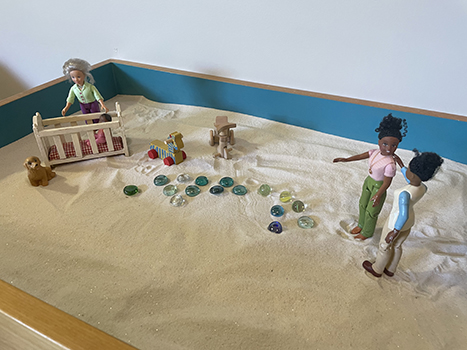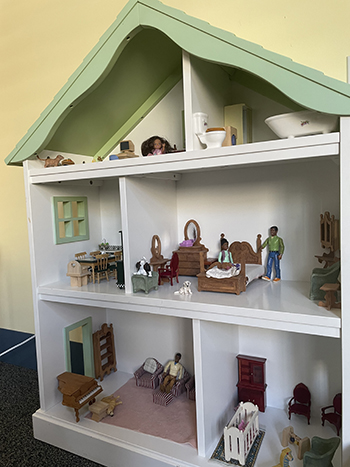Child Therapy FAQs — What Parents Want to Know
Have you ever wondered exactly what child therapy is like? Or if your child’s therapy is truly “working”? Here are some answers to questions that parents and caregivers often ask about therapy with children at BPAR:
- What should I expect when my child starts therapy?
- As a parent, what will my involvement in this process look like?
- What does confidentiality look like for a minor?
- When my child plays in therapy, does that help?
- How long will it take to see progress?
- How much do BPAR clinicians talk about adoption in therapy?
—Darci Nelsen, PhD, LMHC and Madison Janke, LMHC, R-DMT

What should I expect from therapy for my child?
When you reach out to BPAR, you will complete an initial intake phone call and then will be assigned a clinician who will assess your clinical needs. Each therapist has their own theory and modality that becomes the lens through which we approach sessions. Please see our previous blogs on Dance Movement Therapy, Drama Therapy, and Art Therapy as examples of various modalities that BPAR uses. However, every clinician at BPAR is adoption informed and primarily uses play with child clients to establish the therapeutic relationship and as the conduit for therapeutic material to emerge.
Sessions at BPAR are typically between 45 to 55 minutes, depending on the identified goals, clinical needs, and the therapeutic stamina of your child. Session length will be assessed during the initial consultation, in the first session, and throughout the course of the work. There may be times when your child comes into the session with less stamina, and we will work with your child to figure out ways to continue the session or, if needed, ways to conclude the session conscientiously before the scheduled time.
At the beginning of our work with your child, we often recommend that we meet your child for in-person sessions because there is evidence that children respond better to in-person sessions. We do realize that you may have time or distance limitations, and in those cases, we will assess whether your child would be a good candidate for telehealth therapy.
What should I expect my involvement as a parent will be in this process?
Your involvement in the therapeutic process will be dependent on your child’s identified clinical needs and goals. Some of our parents join their children in the session, with the focus on building interpersonal skills and improving the parent/child relationship. For clients with different goals, parent involvement may look like a monthly check-in with their child’s clinician to receive updates on the process, and to share with the clinician how things have been going for the child at home and at school.
Here at BPAR, we use a family systems approach, recognizing that things don’t happen in isolation and something that is affecting one family member will be affecting another. With that in mind, our clinicians value the insight that parents provide and work with families to provide support for them and the identified client.
What does confidentiality mean for a minor?
Confidentiality is crucial in establishing an environment where trust and the therapeutic relationship can be established and work towards identified goals can occur.
When a clinician discusses confidentiality with your child, we discuss three exceptions to the expression “What you say in this therapy space, stays in this therapy space.” We will disclose to parents, if your child endorses any of the following:
- They share an intent to hurt themself (self-harm or intent to end life)
- They share an intent to hurt someone else (homicidal)
- They disclose that they are not being taken care of (neglect/abuse)
In cases when confidentiality needs to be broken, the clinician will typically work with the child to disclose information to parents in a way that feels okay for the child. That may look like a phone call together or pulling the parent into the end of the session to share what was discussed.
Otherwise, confidentiality is held sacred and we limit parent discussions to general themes from the sessions, such as: “In your child’s session, we have been exploring emotion identification, self-regulation strategies, and adoption themes have emerged, such as rejection sensitivity, hypersensitivity to emotions of caregivers, and perfectionism.” If your child gives consent to share more details, we will share those as well.

My child just plays in therapy – how is that supposed to help?
It can sometimes feel confusing when all a child does in their therapy sessions is play–especially if you’re expecting more structured or directive interventions. However, play therapy is a well-established therapeutic approach that is designed to capitalize on the natural communication during a child’s play that supports self-expression and processing of emotions and experiences.
Play can be an especially effective tool for children to express thoughts and emotions they may find hard to articulate, and it also gives them an opportunity to engage in role-play and explore problem solving.
Above all else, play provides a relaxed and comfortable atmosphere where a child can build rapport with a clinician, a prerequisite for establishing the relational trust needed to address more complex topics in therapy.
How long will it take to see progress?
There are a number of factors that influence the length of time it may take for clients to experience progress in therapy, including the nature of the goals, the client’s developmental level, consistency in attendance, the family environment, and the therapeutic relationship.
Short-term therapy may be appropriate for working through specific symptoms or isolated challenges, where long-term therapy is often more suitable for addressing complicated relational dynamics and histories of trauma.
At BPAR, goals for therapy often revolve around complex issues related to adoption that may take time to work through. Our therapeutic model is designed to consider the value of relational attachment and emphasizes the importance of these relationships in the duration of the therapeutic work.
My child doesn’t talk much about their adoption; is that ALL you will talk about in therapy?
At BPAR all our clinicians are trained in adoption-competent therapy, and we understand that adoption touches all aspects of an individual’s life.
For young clients who have not developed the skills and confidence to directly discuss adoption, clinicians may aim to skillfully weave related themes into their dialogue–loss, grief, rejection, relationship, connection. We use a holistic client-centered approach and always aim to collaborate with clients to focus on the topics they find meaningful during sessions, whatever those may include.
Written by Darci Nelsen and Madison Janke
Boston Post Adoption Resources
References
Brazil, C. (2024). How Does Play Therapy Help Adoptees and Therapists? Boston Post Adoption Resources Blog. https://bpar.org/how-does-play-therapy-help-adoptees-and-therapists/
DiBenedetto, K. (2019). The Art of Art Therapy. Boston Post Adoption Resources Blog. https://bpar.org/the-art-of-art-therapy/
DiBenedetto, K., Gorczyca, K., Eckert, J. (2017). Adoption Is a Lifelong Journey. Boston Post Adoption Resources. https://bpar.org/adoption-is-a-lifelong-journey-book/
Elowe, R. (2023). Drama Therapy — Mental Health Awareness Month Spotlight. Boston Post Adoption Resources Blog. https://bpar.org/drama-therapy-mental-health-awareness-month-spotlight/
Janke, M. (2023). Dance / Movement Therapy and Adoption-Competent Therapy. Boston Post Adoption Resources Blog. https://bpar.org/dance-movement-and-adoption-competent-therapy/